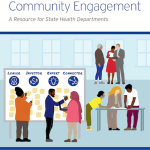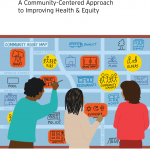By Sarah de Guia
- In the second entry in ChangeLab Solutions’ Democracy & Governance series, CEO Sarah de Guia discusses how community members’ engagement in state and local elections and policymaking builds their power to influence policy in order to meet their needs.
- Voters in this year’s elections hold the power to elect representatives who will protect our rights and advance policies that support community well-being.
- To influence equitable policy change beyond the election, we must engage in policymaking at all levels and all stages of the process.
Voting at All Levels of Government Matters
The upcoming election is important to our health, our economic well-being, our safety, and our democracy. Our vote matters. While many people are rightly focusing on the federal election, thousands of elections are happening at state, county, and city levels, including 13 state gubernatorial elections, 44 state legislative elections, and 368 mayoral elections across the country. Voters will become policymakers as they decide to approve or reject 146 statewide ballot initiatives on issues such as abortion, voter rights, law enforcement, and minimum wage. Voters will also decide races for 32 state supreme court justices, which is important because roughly 95% of court cases brought to state courts affect critical issues such as abortion, voter rights, and equity. How we show up at the ballot box this November matters in very fundamental ways. And regardless of who is elected, how we continue to engage in policymaking will also be vital to our communities.
State & Local Governments Set the Stage for Thriving Communities
Every level of government is critical to our democracy. At the federal level, laws, policies, and funding affect our resources, communities, and access to fundamental supports in important ways. While the federal government sets many parameters for essential policies in areas ranging from food and health care to transportation and infrastructure, state and local governments are largely responsible for implementing them. Combined, state and local governments allocate nearly $4 trillion for public goods and services that people use every day, including health care, education, highways and roads, and housing and community development. According to the US Department of the Treasury, state and local government spending “play[s] a key role in protecting our most vulnerable citizens; keeping our citizens healthy; building and maintaining . . . roads, parks, libraries, and utilities; and investing in our future, most notably in through public education.”
State governments play a key role in protecting and promoting public health because they distribute federal funds that address many health issues such as food contamination and infectious disease outbreaks as well as chronic health conditions such as asthma and heart disease. State and local governments are also responsible for supporting their communities’ unique needs and challenges. But since the COVID-19 pandemic, communities have experienced an increase in attacks on the authority of public health departments to protect the public and a decrease in their budgets to fund public health efforts, as well as an expansion of preemption of local solutions that protect workers, families, and communities. In the face of such pushback, it is crucial that voters engage with state and local ballot measures and vote for representatives who will prioritize improvements in community health.
Strong Community Engagement in Policymaking Leads to Increased Health, Equity & Power
Staff members at ChangeLab Solutions — as advocates, public health practitioners, lawyers, planners, and policy analysts — believe that strong, equitable laws and policies are central to dismantling structural racism and discrimination. The ChangeLab team knows that law and policy alone — without the input, engagement, experience, and guidance of the community members whom the policies will affect — will not achieve the outcomes that we hope for.
To strive for healthier communities, community members must participate in decision making, thereby creating more community cohesion. ChangeLab has long prioritized working with government partners to help them develop practices to increase meaningful community participation and engagement in policymaking. Not only does our team believe in the value of community participation, but research also supports the notion that more engaged communities result in better health outcomes. ChangeLab has experienced the value of community engagement directly in our work with the City of Roanoke, Virginia, and through our cross-sector collaboration with The BUILD Health Challenge.
When community members are involved in decision making — meaning that there is open dialogue between residents and government staff — and when they are empowered — meaning that there is capacity for shared decision making and self-determination — communities are healthier. This result occurs because these engagements and actions support government staff and leaders in gaining a better grasp on culturally appropriate solutions; a deeper and more holistic understanding of the health, economic, and other needs of their community members; and a more comprehensive sense of how their actions and those of other government agencies will help or hinder their community.
Traditional community engagement processes — or lack thereof — have not been supportive of historically marginalized communities. In fact, these processes have in some cases intentionally favored wealthier and more privileged community members. ChangeLab’s recently published community engagement guide, which was supported by the Centers for Disease Control and Prevention, explains ways that state health departments can support local health departments by acting as a leader, connector, investor, or expert (by offering technical assistance to local governments). Government and public health practitioners have many other ways to support equitable community engagement in all stages of the policymaking process; see, for example, ChangeLab’s long-range planning primer for local governments and community-centered planner’s playbook. One step toward engagement in policymaking is to share these and other resources or examples with newly elected or incumbent policymakers, to help ensure that they support inclusive community engagement.
Action Steps for Community Engagement in the Policymaking Process
Our work doesn’t stop on November 5. Engaging in policy, advocacy, and education is central to ensuring equitable and effective public policies. The resources shared in this article offer one pathway for engagement. Here are some additional steps that you, as a government partner or a community leader and advocate, can take in the coming weeks and months:
Government Partners
- Assess your department or division, to understand your readiness for policy change and how to build on assets and strengths.
- Begin building trust through active, two-way conversations and communication between your department or division and community leaders. Look for leaders in places where diverse communities go for connection and assistance. ChangeLab Solutions’ guide to counteracting misinformation also offers ways to engage partners in different sectors to work on common issues.
- Learn from and support community members and leaders, and support existing partnerships.
- Assess which community engagement role (leader, connector, expert, investor) you can take as a first step toward gaining trust within your community.
Community Members and Advocates
- Be sure to confirm your voter registration, do your research on policymakers and any local or state measures that you will be voting on, and help get out the vote on November 5.
- Get to know your policymakers and representatives. Start with local leaders, and work up to your federal representatives. For the names and contact information of your local, state, and federal elected officials, enter your address in the “Elected officials” section of USA.gov.
- Do research to understand your policymakers’ priorities and try to find common ground; websites like Vote411,org and Ballotpedia may have relevant information. You may also wish to look at candidates’ and elected officials’ web pages, their voting records, and local newspapers to find out more. Voices for Healthy Kids’ online guide Finding Commonalities and Solutions with Decision-Makers has information that may be helpful in finding common ground as well as links to other resources.
- Share stories and resources with policymakers to illustrate your community’s needs and values. Share resources to help make the case for policies or issues that you want them to prioritize. FrameWorks Institute, Berkeley Media Studies Group, and Public Health Reaching Across Sectors (PHRASES) are a few organizations that offer information on messaging, connecting with values, and how to advocate for issues that are important to your community.
Building, harnessing, and leveraging community power requires a multipronged approach. The tools are at our fingertips. The time for action is now!
Stay tuned for additional posts in our Democracy & Governance series:
- Blog 3: Governance that creates democracy-forward laws and policies
- Blog 4: Crafting and implementing laws and policies for better health and equity outcomes
10/30/2024


